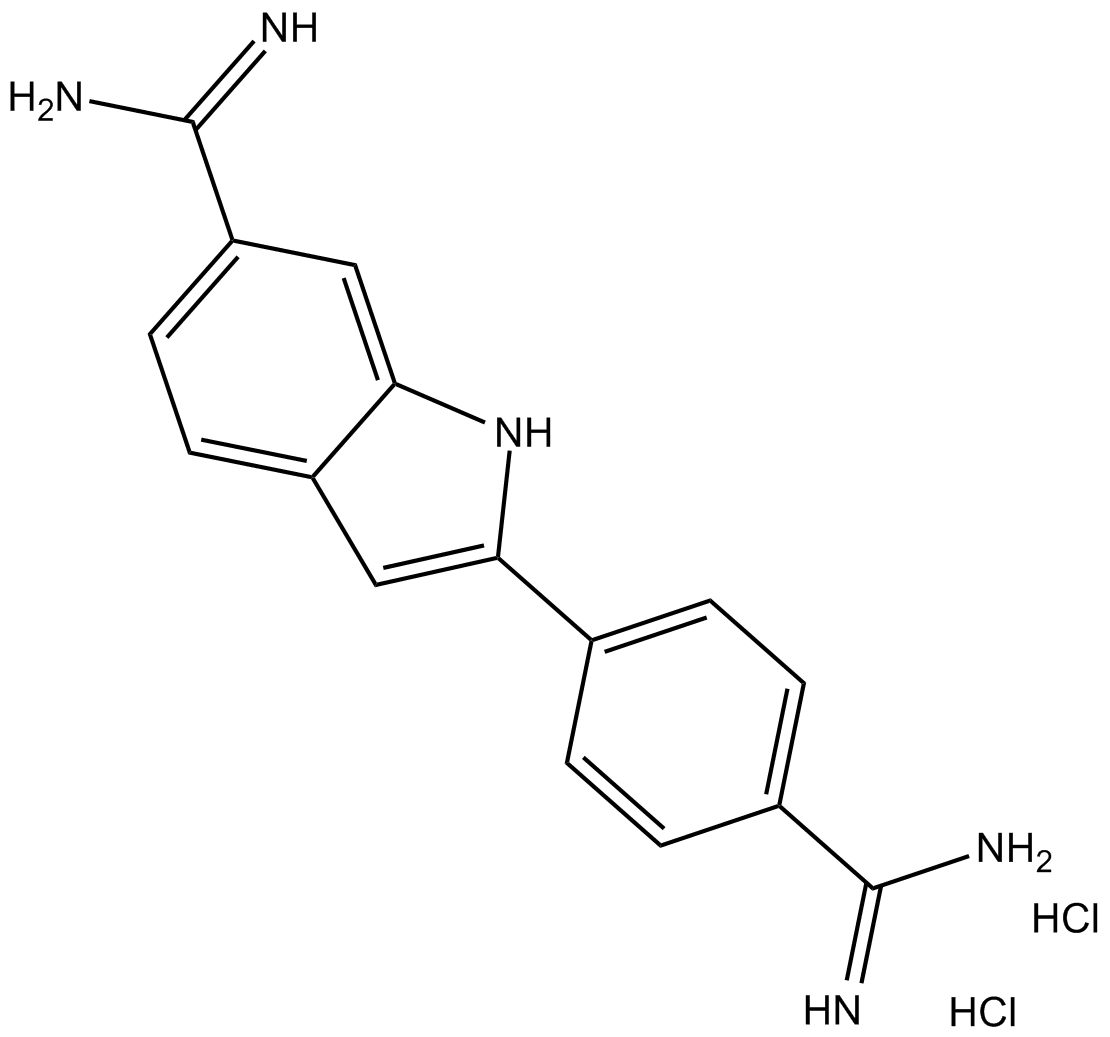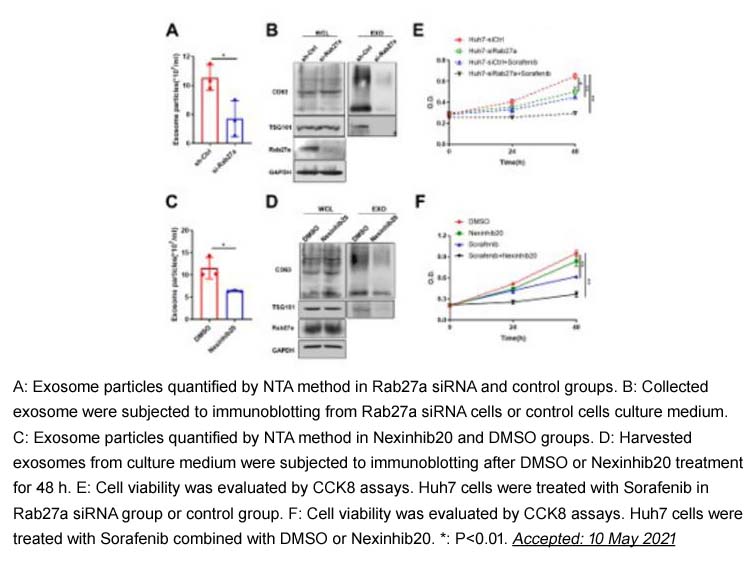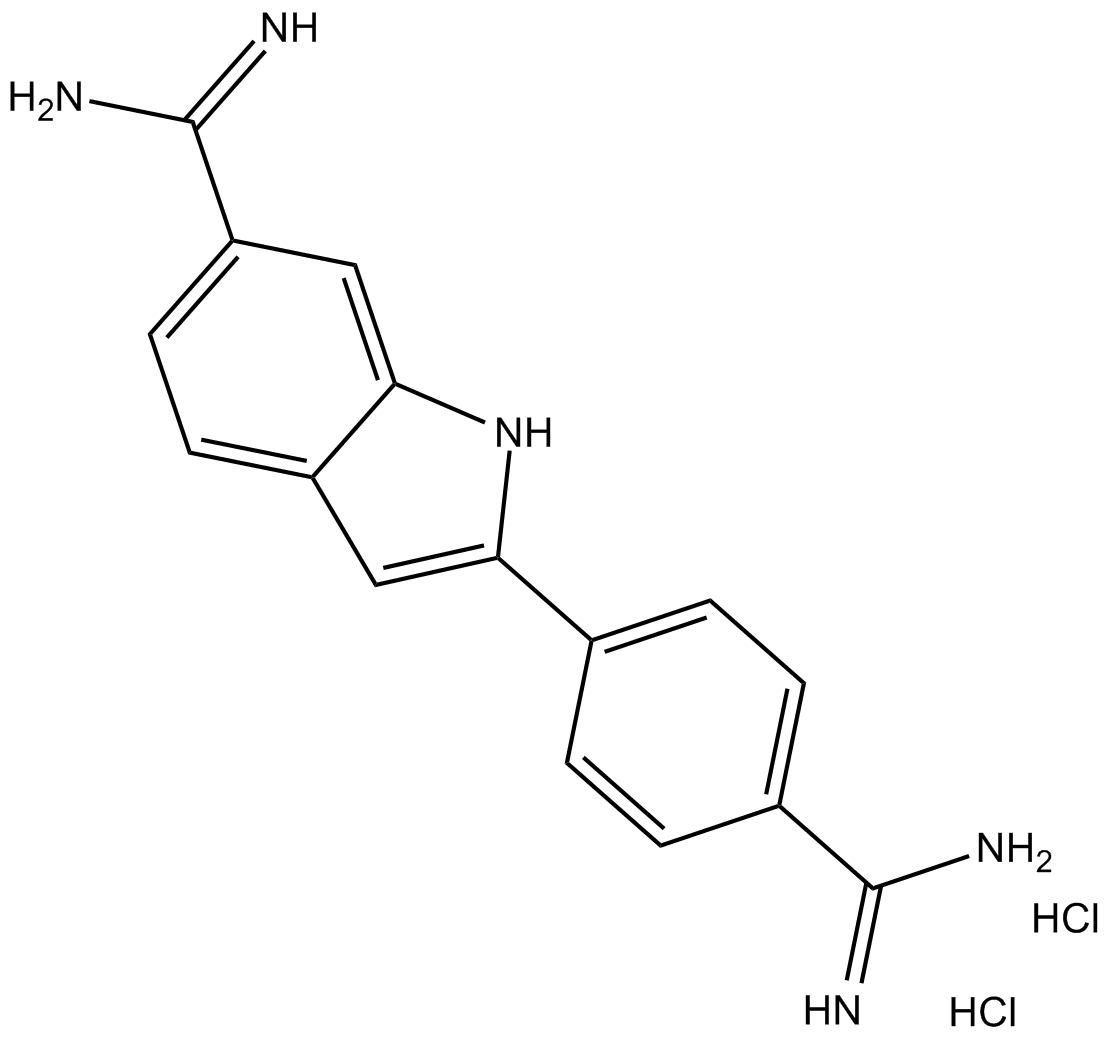DAPI (hydrochloride)
DAPI (hydrochloride) is a fluorescent probe which serves as a DNA-specific probe for flow cytometry, chromosome staining, as well as DNA visualization and quantitation in histochemistry and biochemistry. DAPI forms a fluorescent complex by attaching to the minor grove of consecutive (3 ~ 4 base pairs) A-T rich sequences of DNA. Although DAPI is capable of binding to other sequences of double stranded DNA, or double stranded RNA, these complexes are much less fluorescent. DAPI can be used alone for cell cycle studies of drug effects, or in combination with another fluorochrome for multi-parameter cell analysis. One of the most popular stains combines DAPI with sulforhodamine (SR 101) for simultaneous measurement of DNA and protein content in cells. DAPI can be used on either fixed or live cells, but its low permeability in live cells suggests that higher concentrations should be used.
References:
1. Kapuscinski J. DAPI: a DNA-specific fluorescent probe. Biotechnic & Histochemistry, 1995, 70(5): 220-233.
2. Zink D, Sadoni N, Stelzer E. Visualizing chromatin and chromosomes in living cells. Methods, 2003, 29(1): 42-50.
- 1. Xuanhe Qin, Liping Fu, et al. "Optimized inner ear organoids for efficient hair cell generation and ototoxicity response modeling." Sci China Life Sci. 2025 Jan 23. PMID: 39862345
- 2. Li Yang, Xulei Wang, et al. "A tunable human intestinal organoid system achieves controlled balance between self-renewal and differentiation." Nat Commun. 2025 Jan 2;16(1):315. PMID: 39747097
- 3. Liu Qi, Li Linzhen, et al. "Icariin-containing serum promotes chondrocyte proliferation and chondrogenic differentiation of stem cells in the co-culture system of three kinds of cells." Chinese Journal of Tissue Engineering Research 2025, Vol. 29 Issue (7): 1371-1379.
- 4. Yunqing Jiang, Haowen Qi, et al. "Chlorogenic Acid-Cucurbit[n]uril Nanocomplex Delivery System: Synthesis and Evaluations for Potential Applications in Osteoporosis Medication." Int J Nanomedicine. 2024 Nov 9:19:11577-11592 PMID: 39539971
- 5. Jiawei Yan, Xin Zhang, et al. "Macrophage NRF1 promotes mitochondrial protein turnover via the ubiquitin proteasome system to limit mitochondrial stress and inflammation." Cell Rep. 2024 Sep 25;43(10):114780 PMID: 39325625
- 6. Chunlin Tao, Xiaoge Ni, et al. "MPP7 mediates EMT via Wnt/β-catenin pathway to promote polarity changes in epithelial ovarian cancer cells." J Cancer. 2024 Jun 17;15(14):4490-4502 PMID: 39006077
- 7. Mei Liu, et al. "Shear Bond Strength to Enamel, Mechanical Properties and Cellular Studies of Fiber-Reinforced Composites Modified by Depositing SiO2 Nanofilms on Quartz Fibers via Atomic Layer Deposition." Int J Nanomedicine. 2024 Mar 5:19:2113-2136. PMID: 38476282
- 8. ZHOU Qiyue, HONG Gaoying, et al. "Characterization and biocompatibility analysis of different silanes coupling c (RGDfK) cyclic peptide on titanium surfaces." J Prev Treat Stomatol Dis, 2022, 30(6): 398⁃405.
- 9. Liang Y, Wang J. "Sorafenib-Induced Exosome Secretion Promotes Che-motherapy Resistance in Hepatoma Cell Line." Japanese J Gstro Hepato. 2021; V6(12): 1-7.
| Storage | Store at -20°C |
| M.Wt | 350.25 |
| Cas No. | 28718-90-3 |
| Formula | C16H17Cl2N5 |
| Solubility | insoluble in EtOH; ≥10 mg/mL in H2O; ≥53.3 mg/mL in DMSO |
| Chemical Name | 2-(4-carbamimidoylphenyl)-1H-indole-6-carboximidamide dihydrochloride |
| SDF | Download SDF |
| Canonical SMILES | NC(C(C=C1)=CC=C1C2=CC3=CC=C(C(N)=N)C=C3N2)=N.Cl.Cl |
| Shipping Condition | Small Molecules with Blue Ice, Modified Nucleotides with Dry Ice. |
| General tips | We do not recommend long-term storage for the solution, please use it up soon. |
Quality Control & MSDS
- View current batch:
Chemical structure

Related Biological Data








